by Graham
Hodges
(click on photos to enlarge image)
MINIATURE GEORGIAN SILVER SUGAR TONGS
One hears much discussion about miniature or "small"
Georgian silver sugar tongs. I do discuss the subject briefly in
my book, stating:
"Georgian sugar tongs will generally be between 5 & 6 ins
long, the most common length being approximately 5.1/2 ins long.
Bearing in mind that they were all hand made, it is hardly
surprising to note that the length is never exact. The longest
pair seen are about 6.1/4 ins long, made by George Brasier and
dated around 1790. There are also some very short pairs, perfect
in every respect but only 3 to 4 ins long (I have even seen a
pair of Georgian sugar tongs made by Dorothy Langlands of
Newcastle that were only just over 2 ins long). There are
several theories to explain why tongs were made this size, these
include:
1. They were made for toy sets of silver-ware;
2. They were made as samples for travelling salesmen to display
the maker's arts;
3. They were made by apprentices and made smaller to use less
silver;
4. They were made for people to take on picnics, as part of a "travelling"
set of silver-ware;
5. A patron had specifically tasked the maker with a commission
for a smaller pair of tongs.
Any, or all, of these theories could be true, we will probably
never know. In any event, short sugar tongs are quite rare, and
do look very strange set against standard Georgian tongs. There
is no doubt that they are genuine as they are fully hallmarked.
It is also clear that they have not been repaired, i.e. a broken
piece cut out. "
In fact one does see tongs that are shorter than they should be.
Sometimes this is where a piece has clearly been cut out, either
at the bowls, or at the centre of the bow, presumably in order
to make a repair.
However the real discussion should be about those that do NOT
look obviously repaired. There are three main theories to
explain these:
1. They are fake, i.e. not Georgian at all, made later perhaps
with fake hallmarks;
2. They are actually repaired (and made shorter in the process),
but the repair is too good to detect;
3. They are genuine, i.e. made when the hallmark indicates they
were made, and made shorter than usual.
I will deal with each of these three theories in turn, as in
fact any or all three could actually be true.
FAKE TONGS
My main objection to this theory is "why bother?" The price
of sugar tongs is very low and I find it difficult to imagine
anyone going to the trouble of faking a pair of sugar tongs.
Having said that we do know of a famous case of fake Georgian
silver having been produced, in quantity, and with several
different makers marks punched. The fake silver in this case was
a variety of objects, including sugar tongs. We therefore cannot
rule out forgery. This was discussed in some detail in a paper
by Paul V.A. Johnson, titled "The Lyon and Twinam Forgeries" The
proceedings of the Silver Society, supplied courtesy of The
Goldsmiths' Company Assay Office.
REPAIRED TONGS
I have shown below several examples of repaired tongs. In
most cases the repair is obvious, in some (presumably) to cut
out a piece of damaged silver and make a whole pair. In several
of the examples the "repair" may well not be a repair at all,
simply a "join".
1. Stephen Adams 1791/92
These tongs are 4.1/2 inches long, or 11cms. The bowls have
clearly been joined onto the arms at some point. With this pair,
we can clearly see that the two bowls have been carefully
soldered on to the arms, i.e. added after the arms were made.
The tongs bear a clear hallmark and maker's mark suggesting they
are genuine. Because of the way the bowls have been added the
join appears right at the joint of the bowl on the outside,
sloping back by about 4mm on the inside. The bowls also look
small for the overall size of the rest of the tongs. The bright
cut engraving pattern on the bowls is a pattern often seen with
Stephen Adams tongs and therefore in keeping. The question is;
were they made like this originally, or were the bowls added
later, perhaps as a repair?

|
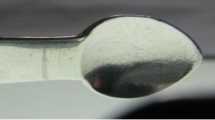

|
silver sugar tongs:
Stephen Adams 1791/92
|
2. William Bateman 1815/16
These tongs are 4.3/4 inches long or 11.9cms. They appear to
be very well proportioned, i.e. the bowls are aesthetically
right and the overall proportions fit well. They are clearly
hallmarked, dated between 1st September 1815 and 28th May 1816.
About 10mm up from each bowl can be seen a small rectangular
inserted piece where the bowls have been joined on to the arms.
This is only very faintly visible on the inside and is almost
invisible from the outside. There is no break in the feather
edge engraving which suggests they were made this way BEFORE
being engraved. This strongly suggests they were made this way
originally. Given that they are only 1/2 to 3/4 inch shorter
than would be normal, it is possible that they were originally
made longer, and were "shortened" for some reason. My
inclination with these tongs is that they came out of the
Bateman workshops appearing as they do now.

|
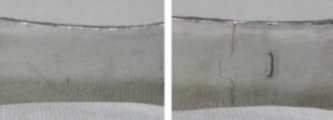
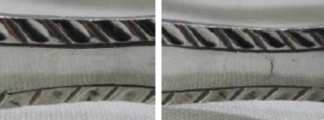
|

|
silver sugar tongs:
William Bateman 1815/16
|
3. George Smith II - c1784
These tongs are just 4 inches long, or 10.2cm. They are
properly hallmarked and dated at around 1784. There are very
clear joins visible about 4mm up from the bowls. These are
solder joins and only really visible from the insides of the
arms. The bright cut engraving appears to be whole from the
outside. The tongs are about 1.1/2 inches shorter than one would
expect. The difficulty is that of assessing whether the "repair"
was made at the time the tongs were made or sometime later. It
is very difficult to be sure either way. It is easy to picture
these tongs being rather longer and the overall form would look
right. At the same time, it is also possible they were made as
they are seen. The overall form does not look too far wrong. If
pushed I would think it more likely the "repair" was made later
and a small piece removed.

|


|
silver sugar tongs: George
Smith II - c1784
|
4. William Seaman - 1818/19
This is a shortened pair of standard bright cut tongs. They
measure 4.3/4 inches or 11.8cms long. The joins where they have
been repaired can clearly be seen about 1/2inch up from the
bottoms of the bowls. The join has been rather cleverly made by
inserting a tiny piece of silver lengthways and then soldering
the arms to the bowls. It appears that between 1/2inch and 1
inch of the arms has been removed. Whether this was done at the
time of manufacture or sometime later is debatable. The fact
that the bright cut engraving seems un-disturbed suggests it was
done at the time of manufacture but we cannot be sure of this.

|
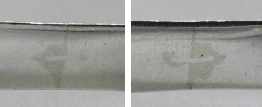
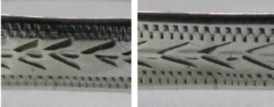
|
silver sugar tongs:
William Seaman - 1818/19
|
5. Thomas Lamborn Sheffield - 1802
This is a shortened pair of tongs. The join can clearly be
seen at the centre of the bow, where a piece has been cut out
and the bow re-joined. The tongs are 4.1/4 inches or 10.8 cms
long. This means a good length has been cut out. Given that one
of the weakest parts of sugar tongs is the bow, it is hardly
surprising that such a repair should be made. These tongs have
clearly been repaired some time after they were made.

|

|
silver sugar tongs: Thomas
Lamborn Sheffield - 1802
|
6. Thomas Wallis II - London 1790/91
This pair of tongs has been shortened through the cutting
out of a piece at the bow. They measure 4.1/2 inches or 11.9cms
long. The repair can very clearly be seen, not just from the
repair line that shows but also because the maker's mark has
been partially cut through during the process. Both the maker's
mark and hallmarks are right underneath the bow where they
should be at the tops of the arms. Notice that the monogram has
been engraved some time after the repair was made. They are
dated 1790/91.

|
 |
silver sugar tongs: Thomas
Wallis II - London 1790/91
|
7. Edward Lees - London 1804
These are a particularly small pair of tongs, just 3.1/2
inches or 9.2 cms long. The arms are narrow, in proportion with
their overall size. They are very clearly hallmarked, in the
normal place with good clear hallmarks for 1804 (between 29th
May and 10th October). They "look" right in every respect. They
have clearly been repaired at the bow. My view is that these
tongs were actually made this size and have been repaired at
some point in their life. This is as opposed to have been
shortened at some time.

|
 |
silver sugar tongs: Edward
Lees - London 1804
|
8. Christopher & Thomas Wilkes Barker - London 1803/04
This pair of tongs is just slightly less than 4 inches long,
but proportionally the same as larger Georgian tongs. There is
often some doubt over whether these types of tongs are made as
they appear, or whether they have been cut down. A close look at
the join between the arms and bowls clearly shows solder marks
where the bowls have been joined to the arms. The question is
whether this was done at the time of making or later. My
personal view is that they are genuine, not cut down and
repaired. This view is taken because of the overall proportions.

|
 |
silver sugar tongs:
Christopher & Thomas Wilkes Barker - London 1803/04
|
9. William Ellerby - 1808/09
These tongs are just 4.1/2 inches long. One can clearly see
the join marks on the sides of both arms. These joins have been
very carefully made and it is unclear whether this was done at
the time of manufacture or later, as a repair. A close look at
the engraving on the sides of the arms shows that they were
engraved AFTER they were shortened - curious?? These tongs also
have a very elaborately engraved monogram.

|
 |
silver sugar tongs:
William Ellerby - 1808/09
|
GENUINE TONGS
We now move on to the tongs that I have labeled as
"Genuine". These tongs are all small, but none have any marks
that suggest that they may have been made in several parts or
repaired or later made smaller. I suggest that all of these
tongs were actually made the sizes that they currently are.
1. Thomas Purver & Edward Furnice - 1815
These tongs are very plain and in a fairly standard "Old
English" style, typical for the period. They are just 4 inches
(10.3cms) long. They are fully hallmarked, with the un-clipped
duty mark showing a date of between 28th May and 13th June 1815.
There are no marks anywhere to suggest any repairs.

|
 |
silver sugar tongs: Thomas
Purver & Edward Furnice - 1815
|
2. Stephen Adams I - 1790/91
This is an absolutely gorgeous little pair of sugar tongs.
They are just 4 inches (10cms) long and in pristine condition.
They are dated 1790/91. The assay office has clearly had some
trouble punching their mark - perhaps they should have punched
it sideways! These tongs are a lovely example of miniature tongs,
with no marks whatsoever indicating any kind of repair. The
proportions are also right for their size.

|
 |
silver sugar tongs:
Stephen Adams 1 - 1790/91
|
3. George Smith & William Fearn 1793/94
These miniature tongs are just 3.1/2 inches (9.2 cms) long.
They are perfectly proportioned and clearly hallmarked. They
show no signs of any repair. They are dated 1793/94.

|
 |
silver sugar tongs: George
Smith & William Fearn 1793/94
|
4. Samuel Whitford I
These tongs are just over 4 inches (10.5 cms) long. They are
shaped and have a delicate thread edge. The bowls are circular
and engraved although the engraving is worn. As well as being
miniature tongs, they are also an example of duty dodging as
they are marked with only the maker's mark, marked twice, one on
each side of the arm. I have dated them as c1780-84.

|
 |
silver sugar tongs: Samuel
Whitford I
|
5. John Steward
These tongs are 4.1/4 inches (11.0 cms) long. They are
marked in the bowls with the script maker's mark for John
Steward. Even on very close inspection one can see no sign of a
break or repair.

|
silver sugar tongs: John
Steward
|
6. Peter, Ann & William Bateman
We now come to two identical pairs of tongs from the Bateman
shops. This first pair is by Peter, Ann & William. They are 4
inches (10.3cms) long and are in correct proportions for their
size.

|
silver sugar tongs: Peter,
Ann & William Bateman<
|
7. Peter & William Bateman
Whilst difficult to see much difference from the picture,
this second pair is by Peter & William Bateman.

|
silver sugar tongs: Peter
& William Bateman<
|
8. William Eley & William Fearn - 1816/17
These tongs are just over 4 inches (10.5 cms) long. They are
in almost pristine condition and show no signs of any repair.
They are dated 1816/17. Interestingly they are bright cut and
most of Eley & Fearn's tongs of this time were plain, without
bright cut engraving.

|
silver sugar tongs:
William Eley & William Fearn - 1816/17
|
9. Charles Hougham
The final pair are by Charles Hougham. They are just 3.3/4
inches (9.3cms) long. They are in superb condition, bright cut
engraved and fully hallmarked in the bowls. There is no sign of
any repair which would mean that these tongs were made this size.
They are dated between 1786 & 1790.

|
silver sugar tongs:
Charles Hougham
|
CONCLUSION
Some of these smaller tongs are definitely repaired tongs.
Some are questionable, i.e. whether they were "repaired" at the
time of manufacture or later. There are also tongs that show
every appearance of having been made as miniatures. My view is
therefore that tongs WERE made as miniatures, but we are still
no clearer as to why.
All of the above tongs are published on my web-site
www.silversugartongs.com
Graham Hodges
- 2013 -
Graham Hodges is the owner of
www.silversugartongs.com website and the author of
the book "Georgian silver sugar tongs", the only known
book published on this subject matter
|
|
|




































